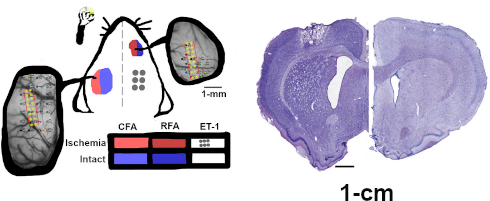Successful Dissertation Defense
Published:
Published:
Published:
Published:
Published:
Published:
Published:
Published:
c/c++ that allowed for very-high fidelity in logging from devices across several different operating systems/distributions. I’ve included the relevant doxygen documentation on the NML-WTF website. Read morePublished:
Published:
Input_Utilities code repository. You may have guessed where this is headed. Read morePublished in Frontiers in Cellular Neuroscience, 2016
This is a review of the challenges facing the translation of brain computer interfaces from preclinical trials to widespread use in the clinic. There is an emphasis on activity-dependent stimulation and similar paradigms. Read more
Recommended citation: Murphy, M. D., Guggenmos, D. J., Bundy, D. T., Nudo, R. J. (2016). Current challenges facing the translation of brain computer interfaces from preclinical trials to use in human patients. Frontiers in cellular neuroscience, 9, 497. (Link)
Published in Journal of Bacteriology, 2017
This paper is about the localization of lipoproteins to a particular side and layer of the bilayer membrane of Borrelia, the causative agent of Lyme disease. It is a descriptive study that catalogues this specific property of each putative lipoprotein identified in the Borrelia lipoproteome. Read more
Recommended citation: Dowdell, A. S., Murphy, M. D., Azodi, C., Swanson, S. K., Florens, L., Chen, S., Zuckert, W. R. (2017). Comprehensive spatial analysis of the Borrelia burgdorferi lipoproteome reveals a compartmentalization bias toward the bacterial surface. Journal of bacteriology, 199(6). (Link)
Published in International Symposium on Circuits and Systems, 2018
This paper is about a proof-of-concept nonlinear dynamical systems approach applied to peri-stimulus epochs to see if it could detect longitudinal differences in how open- and closed-loop influence the system response to electrical microstimulation of sensory cortex in ambulatory rats. Read more
Recommended citation: Murphy, M. D., Dunham, C., Nudo, R. J., Guggenmos, D. J., Averna, A. (2018, May). Assessing Perturbations to Neural Spiking Response Dynamics Caused By Electrical Microstimulation. In 2018 IEEE International Symposium on Circuits and Systems (ISCAS) (pp. 1-5). IEEE. (Link)
Published in Journal of Neural Engineering, 2019
We modified the Intan Stimulation/Recording controller to deliver closed-loop stimulation using a finite state machine to improve artifact rejection, such as may occur due to electrical microstimulation or other physiological events such as chewing and whisking. Read more
Recommended citation: Murphy, M., Buccelli, S., Bornat, Y., Bundy, D., Nudo, R., Guggenmos, D., Chiappalone, M. (2019). Improving an open-source commercial system to reliably perform activity-dependent stimulation. Journal of neural engineering, 16(6), 066022. (Link)
Published in PLoS ONE, 2019
Rats were trained on a gross (lever-press) and fine (pellet-retrieval) forelimb task, implanted with microwire arrays spanning unilateral sensorimotor cortex contralateral to the moving limb, and then tested over the course of days and weeks to determine the longitudinal stability of both spiking unit signals as well as gamma LFP in this context. Read more
Recommended citation: Bundy, D. T., Guggenmos, D. J., Murphy, M. D., Nudo, R. J. (2019). Chronic stability of single-channel neurophysiological correlates of gross and fine reaching movements in the rat. PloS one, 14(10), e0219034. (Link)
Published in Cerebral cortex, 2020
Intracortical microstimulation (ICMS) was applied to the rat primary sensory cortex in healthy anesthetized rats using both closed- and open-loop paradigms. Changes in firing rates and regimes were tested over the course of a few hours to determine if an effect differentiating the protocols could be detected during this time. Read more
Recommended citation: Averna, A., Pasquale, V., Murphy, M. D., Rogantin, M. P., Van Acker, G. M., Nudo, R. J., Guggenmos, D. J. (2020). Differential effects of open-and closed-loop intracortical microstimulation on firing patterns of neurons in distant cortical areas. Cerebral Cortex, 30(5), 2879-2896. (Link)
Published in Brain Stimulation, 2020
We tested whether transcranial direct-current stimulation (tDCS) had any effect on the spike rate or LFP content in ambulatory rats using a within-subject design to test anodal, cathodal, and sham stimulation cases. Read more
Recommended citation: Milighetti, S., Sterzi, S., Fregni, F., Hanlon, C. A., Hayley, P., Murphy, M. D., Nudo R. J., Guggenmos, D. J. (2020). Effects of tDCS on spontaneous spike activity in a healthy ambulatory rat model. Brain Stimulation, 13(6), 1566-1576. (Link)
Published:
Data processing pipeline for neurophysiological data collected in studies related to rehabilitation from injury to the nervous system.
Published:
We recorded extracellular field potentials from microwire arrays embedded in the contralateral rostral forelimb area (RFA) and the ipsilateral caudal forelimb area (CFA) with respect to the preferred forelimb used during pellet retrievals by rats. A subset of rats received a focal vasoconstrictive ischemia in CFA contralateral to the preferred reaching forelimb, which led to clear motor deficits on this task.  Read more
Read more
Published:
A proof-of-concept web API for storing model parameters, small dynamic datasets, etc. Read more
Talk, Rockhurst, 2017
I gave an invited guest lecture describing principles of neuroplasticity as it applies to neurorehabilitation, with emphasis on brain-computer interfaces and closed-loop stimulation strategies designed to augment physical therapy. Read more
Poster, State Capitol Building, 2017
I presented a poster on a Hidden Markov Model that decoded the information transfer rate of nodes in a network within anesthetized rat rostral forelimb area (RFA) as a potential model for evaluating changes in information rate following different intracortical microstimulation (ICMS) modalities. Read more
Talk, University of Kansas Medical Center, 2019
I made it to the final round of the KUMC three-minute thesis competition where I presented work that was ultimately published in Journal of Neural Engineering, describing a low-latency, high-fidelity spike discriminator that I implemented for the Intan Stimulation/Recording controller together with my collaborator, Stefano Buccelli. Read more
Talk, Global (Zoom), 2020
Talk, Carnegie Mellon University (Zoom), 2020